A Brief History:
The first records of organisational improvement were found during the Industrial Revolution when engineers began analysing people at work and thinking about improving workplace efficiency.
One of the first written examples is by Fredrick Taylor and his 1911 best seller, “The Principles of Scientific Management”. Taylor believed that to improve an organisation it was important to study worker’s movements in detail and measure them against each other.
Other key theorists include Elton Mayo and Abraham Maslow, who both studied the psychological needs of workers.

In 1951 William Ouchi introduced Theory Z into organisation development theory through his book “Theory Z: How American Business Can Meet the Japanese Challenge”. This research focused on understanding what motivates people to be productive when they are not directly compensated for their work. This ground-breaking research would later develop into the Toyota Production System.
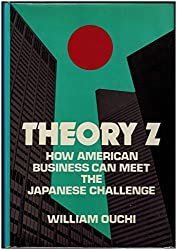
The 1960s saw a growing interest in organisational development as an academic discipline which lead to research and teaching of Organisational Development, with universities such as Stanford University establishing their own departments for managing organisations.
In 1979 one of the most influential books on OD was published: “Organizing For Results: The Executive’s Guide To Planning And Managing Organizational Change” by Dr. Henry Mintzberg and John Izzo.
In the 1980s, OD was well established in business but not yet popular with academics or practitioners of human resources management.
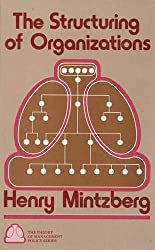
The 1990s brought a new wave of research into organisational development which focused on improving performance through innovation and knowledge management as opposed to traditional operational effectiveness issues such as efficiency gains from better techniques for managing people, machines, materials and information flows. This led to the creation of the discipline of Knowledge Management and its associated concepts such as information overload, knowledge management processes, and human capital.
In 2000 organisational development began to shift from a more-or-less traditional emphasis on efficiency gains in operational effectiveness areas to an emphasis on innovation (creativity) as well as service quality improvement through creativity and cross boundary collaboration. The concept that emerged was called “Organizational Creativity” which it defined by three practices: problem solving; new product/service design; and workforce retraining for creative skills.

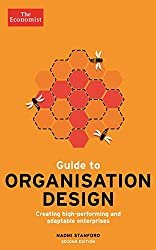
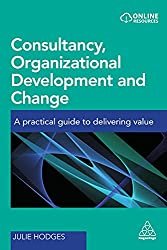
The Values of OD
The values of Organisation Development are important because they are the foundation on which the OD profession is built. There are four main values:
- A belief that organisations should be guided by a set of shared moral and ethical principles;
- An acceptance that there can be no single best way to organise, rather it will depend on the situation or context;
- The idea that people at all levels in an organisation have something important to contribute as well as knowledge about what they need for their own personal development; and
- Finally, Organisational Development professionals believe in collaboration with other professions such as HRM, entrepreneurship and community engagement. These practices allow them to work effectively across sectors, disciplines and regions. Therefore this value speaks not only to one’s individual contribution, but also how teams may collaborate together.
Theories of Organisational Development
Theories of Organisational Development can be defined in a few ways. One way is that they are ideas about how to create change and development within organisations, typically with some form of intervention from outside consultants or practitioners.
The other definition of theories of organisational development is the idea that these theorists have come up with frameworks for understanding what transformation looks like in an organisation and different approaches to achieving this goal. This could include looking at organisational culture, structures as well as systems and processes such as HRM (Human Resource Management), ICT (Information & Communications Technology) etc., which require transformations themselves before any changes can occur on the wider scale.
Friedman’s Theory:
Frederick T Friedman was an American who developed Organisational Development theory through his work studying with organisations such as the International Business Machines Corporation. Friedman’s theory of Organisational Development is seen as a more scientific approach to understanding organisations, in contrast to McGregor’s Theory X and Theory Y which are viewed as psychoanalytical approaches.
Friedman developed his theories while studying at Yale University with the help of other famous academics such as Robert F Wagner Jr., who had been on President Eisenhower’s cabinet and was also appointed chairman for Metropolitan Life Insurance Company.
The OD process that Friedman outlined can be summarised in six steps:
- diagnosis (when an organisation realises it needs change),
- insight (recognising what problems need addressing),
- study/planning (thinking about how best to address those issues,
- action, evaluation or review (checking how successful the changes have been),
- experience/feedback,
- and finally, new action.
Practices of Organisational Development
Organisation development is a process to assist organisations in achieving their objectives. It can be achieved through various tools including leadership, culture and change management strategies.
The six practices that an organisation may engage in during the organisational development process these include:
- Assessment and diagnosis: an organisation must take stock of its current position, to identify what needs improvement. This is often done through a SWOT analysis or other diagnostic process.
- Insight: once the problems have been identified, leadership will need insight as to how best to address these issues (insight may be gained from staff, research or consulting firms)
- Study/planning: plans are needed for addressing the issue(s) that were found in the first two steps of organisational development; study and planning allow organisations to form possible approaches before implementing them. These plans typically include team objectives with timelines and budgets. They also involve engaging external experts who can help develop new policies or practices within the company’s culture
- Execution: this stage of the process involves implementing these plans to ensure that the organisation is moving in a positive direction
- Evaluation and feedback loop: once again, evaluation and feedback loops are used at each step of organisational development; they help organisations learn from their mistakes as well as keep on track with what needs improvement
- New Action and Business as usual: time must be given for new practices and ways of working to take root and become the new way “we do things around here”. These new practices should be evaluated against improved (higher) levels of performance, as the organisation continues to “develop itself” (organisational development).
Key Organisation Development Models
There are many approaches used in organisational development; they include Burke-Litwin, McKinsey 7s, Nadler & Tushman’s Congruence Model, Tuckman and Lewin.
Each approach has their own set goals for how organisations should be run with different models at each stage of the process. All have an eye on key concepts like continuous improvement, strategic planning, systems theory, behavioural science, business processes, performance management, total quality management, people management, workplace culture, competitive advantage, employee engagement, and organisational effectiveness.
Burke & Litwin:
This model has a four-stage process, with each following stage building on the other. The first is ‘the introduction’, which focuses on setting strategic goals for the organisation and assessing its strengths and weaknesses. Second is ‘analysing’ where plans are formulated to increase effectiveness of organisational performance; the third is ‘implementing’ the plans; and, finally, there’s stage four called ‘evaluating’. This model of organisational development, a favourite among OD and Change professionals due to its inclusiveness for all aspects of the organisation, and is one of the few models that takes into account all aspects of an organisation.
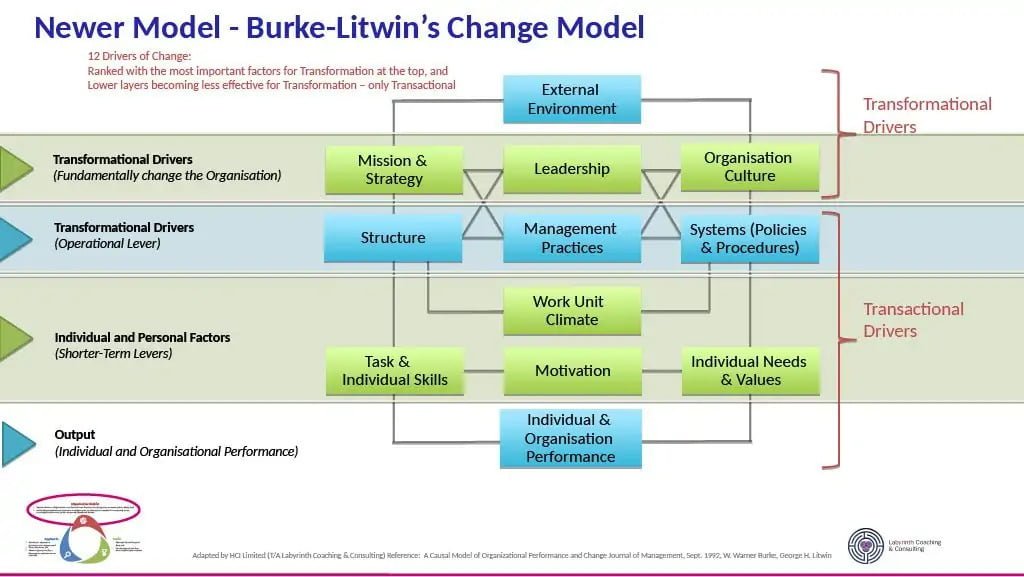
McKinsey 7s Model:
The McKinsey 7s model is a management model encompassing Strategy, Structure, Systems, Staff, Style, Skills and Shared Values. This view of the organisation is said to have originated at McKinsey & Company in the 1940s and was originally called “The General Survey”. This model has been used for more than 50 years by organisations around the world to define their organisation and develop strategy. In recent years, the seven-stage model has been updated to include the importance of innovation and culture.
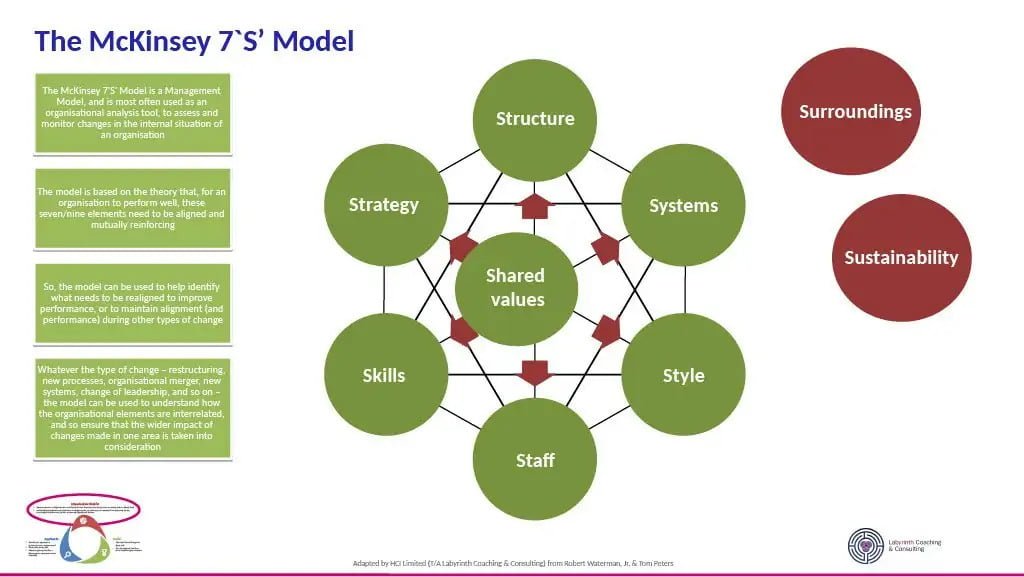
Congruence Model
Nadler & Tushman’s Congruence Model is a theory of organisational development that consists of four stages: Incongruence, Congruence, Discongruence and Re-Congruence. To achieve long-term success, an organization must constantly evolve by seeking equilibrium in each new stage it traverses. Continuously striving for re-congruence is the key to true competitiveness because “it’s inevitable for organisations to become incongruent with their environment and this can lead them into a downward spiral that could be fatal.”
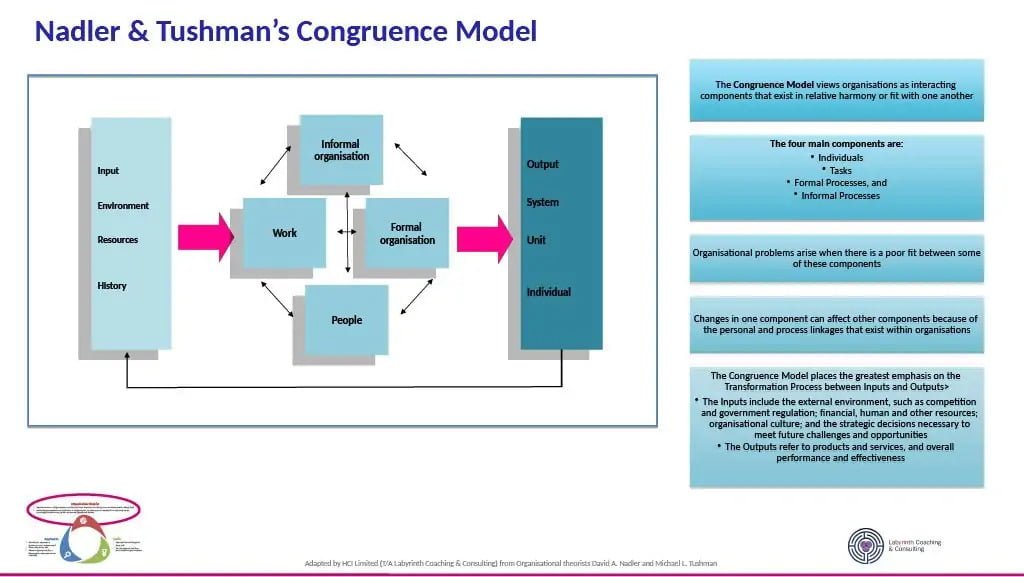
Tuckman’s Model of Team Development
Tuckman: this model has a five-step process – from forming to norming to storming until reaching a goal in each one. The first step of Tuckman’s model is ‘forming’ where people are brought together for the organisation and its shared vision. It continues with ‘norming’ when they start working as an integrated team that thinks similarly about what goals should be met by all members. Next comes “storming” where conflicts arise among people who have different ideas on how things should work within the company which often creates tension or disagreement (even arguments). This is followed by ‘performing’ where people come together to solve the issues or disagreements within the team. The fifth and final stage, called “adjourning” occurs when members of an organisation are dissolving their relationship with each other after they’ve reached a common goal.” The attention to group dynamics is a key skill for OD practitioners and Change Professionals.
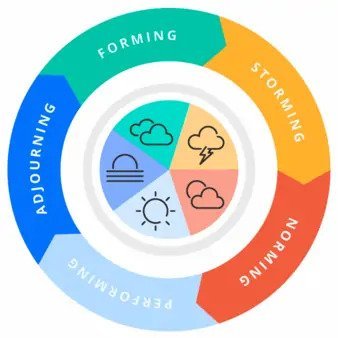
Lewin’s Model of Change Management
Lewin’s approach is wide-ranging and is a useful framework for examining the life of an organization. It provides insights into what drives change in organizations, why they are so resilient to external forces and how employees can be more effective at transforming their work environment. Lewin developed ‘Field Theory’ in order to examine group behaviour – he believed that shared feelings amongst members were essential in determining attitudes towards change. Field theory is also important because it emphasises how employees can be more effective at transforming their workplace environment.”
Lewin developed ‘Field Theory’ in order to examine group behaviour – he believed that shared feelings amongst members were essential in determining attitudes towards change. Field theory is also important because it emphasises how employees can be more effective at transforming their workplace environment.”

How Does Organisational Development differ from Organisation Design?
Organisation Development, also known as Organizational Development (OD) or Organization Development and Change Management is a systematic process of facilitating change to help organisations thrive. This may involve organizational restructuring, workforce reduction strategies, re-engineering work processes or altering the culture.”
What is organisation design? Organisation Design is the process of designing an organization for a specific purpose. This can be done through various methods – including restructuring and reorganizing, outsourcing functions or services to other companies, merging two (or more) organizations together.”
Organisation Development and Organisation Design work hand-in-hand to facilitate superior organisational performance with an engaged and aligned workforce to achieve the strategic goals of the organisation.
Galbraith’s ‘Star’ Model
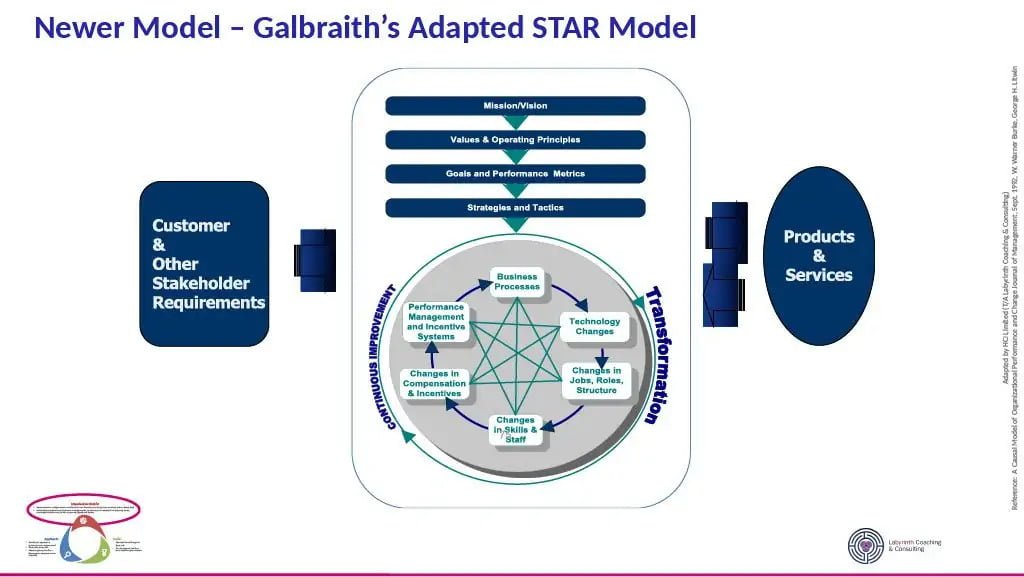
Galbraith (1977) identified five key phases of organisational design:
The first phase is the design process. This includes aspects such as goals, objectives and strategies to achieve those goals.”
In this stage it is important that there is a clear understanding of what the organisation does so that you can correctly identify the key drivers of success.
The second phase is design articulation or what the organisation should look like.”
In this stage, it is important to articulate the desired outcomes so that everyone in the organisation has a common understanding and vision for how things should be done.
This includes identifying what people do within the organisation, and what they need to be able to do.
The third stage is design development, or how the organisation should look.”
In this phase, it is important to consider all aspects of the organisational design so that the desired outcomes are achieved with minimum wastage and maximum efficiency.
This includes planning for any foreseeable changes in market conditions or the overall environment.
The fourth stage is implementation or putting it all together. It involves taking the designs from stages one through three and developing them into a workable plan for successful operating model of the new organisational design. This includes deciding how many people will be needed, and what they need to be able to do.
The fifth stage is evaluation or assessment of the new design and its effectiveness in achieving desired outcomes, which includes checking whether it meets objectives and has a positive impact on organisational performance.
HR in Relation to Organisation Development
HR performs a key role in Organisation Development by providing expert advice on how to transform the organisation from within. This is because HR professionals are able to understand and anticipate the effects on employee motivation and overall performance by any organisational change, (no matter the size or complexity of that change).
Strategic HR are able to provide the leadership team with sound advice and perspectives on how to improve performance, manage change or create an engaged workforce. HR professionals are able to do this through data driven insight into organisational effectiveness.”
In addition, HR professionals are also able to provide expert feedback on how new initiatives will impact the workforce. HR professionals are in the unique position to provide insights and advice to senior leaders on how key talent decisions such as hiring, evaluating and developing staff can improve organisational performance.
This is because they are able to offer a 360-degree view of the organisation through engagement with employees at all levels. As well as feedback from line managers who have an understanding of business units or functions.
There is a clear link between OD, HR and Change professionals, with all three professions working closely together in the organisation.
Organisational Development & Leadership
“Organisation Strategy is What the organisation is planning to achieve; OD Strategy is How the organisation will achieve the strategic goals”. This simple, but powerful idea perfectly illustrates how OD strategy sits along Organisational strategy, and why Leaders need to have a holistic view of the organisation when planning and implementing any organisational change.
In order to be successful, organisational development efforts need support from Leaders and upper management.
All changes interventions need to take into account People, Processes, Systems and Information. These four categories need to be aligned and working in harmony. The more aligned, the more enabled the Organisation is to achieve its strategic goals.
Leaders should be at the forefront, collaborating with other departments to ensure OD interventions are aligned and effective, and that all aspects are considered.
Summary
OD strategies need to align around strategic goals of the organisation because these goals dictate what needs to happen within an organisation in order for it to develop or transform successfully. OD should not just be practiced by OD professionals but by every member of the organisation, and driven by the top leadership.
Organisation Development matters because it is the process of helping people, processes and systems work together to achieve a common goal.


One Response